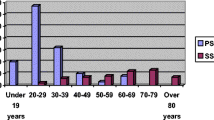Abstract
Purpose
There has been speculation that weather changes correlate with the incidence of spontaneous pneumothorax, although this has not been verified. Moreover, there are no significant data available on the meteoropathic pneumothorax in Asia. The aim of this study was to investigate the possible correlation and to compare our results to those of the United States and Europe.
Methods
From January 2000 to December 2009, 317 spontaneous pneumothorax cases with clear dates of onset were treated in our institution. Using the meteorological data of Fukuoka, Japan, the days with and without an occurrence of pneumothorax were statistically compared in terms of atmospheric pressure, the amount of precipitation, temperature, humidity, hours of sunshine, and occurrence of a typhoon and lightning.
Results
Multivariate analysis revealed that a decrease in the hours of sunshine, an increase in mean temperatures 2 days before the incidence, and the days following a day with lightning were all significantly correlated with the occurrence of pneumothorax (P = 0.2 days before the incidence, and the days following a day with lightning were all significantly correlated with the occurrence of pneumothorax (P = 0.0083, 0.0032, 0.0351, respectively). However, typhoons, as an “unusual” weather condition, did not influence the incidence of pneumothorax (P = 0.983).
Conclusions
Our results show strong similarities with reports from European countries despite the different climates. We conclude that the occurrence of pneumothorax appears to correlate with some weather conditions in Japan.
Similar content being viewed by others
References
Bense L. Spontaneous pneumothorax related to falls in atmospheric pressure. Eur J Respir Dis 1984;65:544–546.
Scott GC, Berger R, McKean HE. The role of atmospheric pressure variation in the development of spontaneous pneumothoraces. Am Rev Respir Dis 1989;139:659–662.
Alifano M, Forti Parri SN, Bonfanti B, Arab WA, Passini A, Boaron M, et al. Atmospheric pressure influences the risk of pneumothorax: beware of the storm!. Chest 2007;131:1877–1882.
Smit HJ, Devillé WL, Schramel FM, Schreurs JM, Sutedja TG, Postmus PE. Atmospheric pressure changes and outdoor temperature changes in relation to spontaneous pneumothorax. Chest 1999;116:676–681.
Ozpolat B, Gözübüyük A, Koçer B, Yazkan R, Dural K, Genç O. Meteorological conditions related to the onset of spontaneous pneumothorax. Tohoku J Exp Med 2009;217:329–334.
Suarez-Varel MM, Martinez-Selva MI, Llopis-Gonzalez A, Martinez-Jimeno JL, Plaza-Valia P. Spontaneous pneumothorax related with climatic characteristics in the Valencia area (Spain). Eur J Epidemiol 2000;16:193–198.
Bulajich B, Subotich D, Mandarich D, Kljajich RV, Gajich M. Influence of atmospheric pressure, outdoor temperature, and weather phases on the onset of spontaneous pneumothorax. Ann Epidemiol 2005;15:185–190.
Ayed AK, Bazerbashi S, Ben-Nakhi M, Chandrasekran C, Sukumar M, Al-Rowayeh A, et al. Risk factors of spontaneous pneumothorax in Kuwait. Med Princ Pract 2006;15:338–342.
Tzani P, Pisi G, Aiello M, Olivieri D, Chetta A. Flying with respiratory disease. Respiration. 2010;80:161–170.
Chen CH, Kou YR, Chen CS, Lin HC. Seasonal variation in the incidence of spontaneous pneumothorax and its association with climate: A nationwide population-based study. Respirology 2010;15:296–302.
http://www.data.jma.go.jp/obd/stats/etrn/index.php. Accessed January 12, 2011.
Mukamal KJ, Wellenius GA, Suh HH, Mittleman MA. Weather and air pollution as triggers of severe headaches. Neurology 2009;72:922–927.
Vergés J, Montell E, Tomàs E, Cumelles G, Castañeda G, Marti N, et al. Weather conditions can influence rheumatic diseases. Proc West Pharmacol Soc 2004;47:134–136.
McGorry RW, Hsiang SM, Snook SH, Clancy EA, Young SL. Meteorological conditions and self-report of low back pain. Spine 1998;23:2096–2102.
Shutty MS Jr, Cundiff G, DeGood DE. Pain complaint and the weather: weather sensitivity and symptom complaints in chronic pain patients. Pain 1992;49:199–204.
Santić Z, Santić Z, Santić K, Kondza D, Bogut S. The relationships between the asthma and weather. Med Arh 2002;56:155–157.
Deisenhammer EA, Kemmler G, Parson P. Association of meteorological factors with suicide. Acta Psychiatr Scand 2003;108:455–459.
Thurlbeck WM, Churg A. Pathology of the lung. 2nd ed. New York: Thieme Medical; 1995. p. 1080.
Author information
Authors and Affiliations
Rights and permissions
About this article
Cite this article
Obuchi, T., Miyoshi, T., Miyahara, S. et al. Does pneumothorax occurrence correlate with a change in the weather?. Surg Today 41, 1380–1384 (2011). https://doi.org/10.1007/s00595-010-4482-y
Published:
Issue Date:
DOI: https://doi.org/10.1007/s00595-010-4482-y




